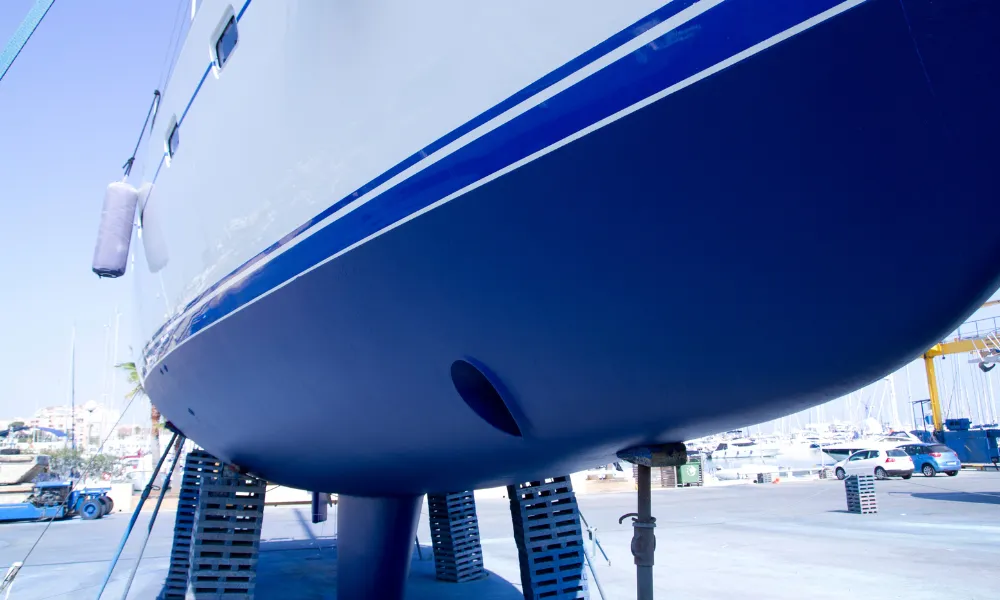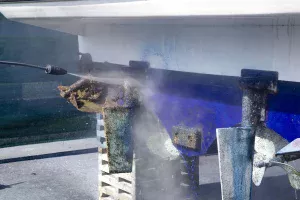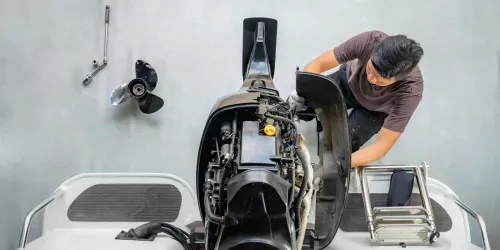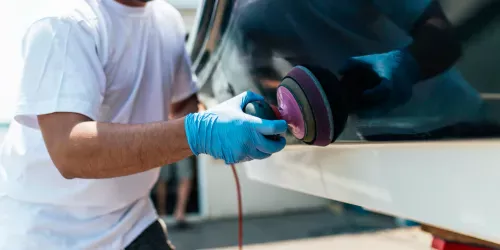As you know, a boat requires attentive maintenance. Even more so when your boat's hull is permanently underwater. This is where antifouling comes in...
Indeed, this contact with the water leads to the appearance of a set of plants and animals that stick to the white water of your boat. This phenomenon is problematic because it reduces your sailing performance, your speed is reduced and your fuel consumption increases.
To prevent algae, mussels and shellfish from growing, you should protect your boat's hull with a specific marine paint, called "antifouling". We will help you better understand this phenomenon, choose your antifouling paint properly and apply it in the best way.
The reactions of your hull to water.
As mentioned above, the prolonged immersion of your hull like any other submerged body causes the proliferation of a complex marine biotope. This colonization of algae and other organisms on the hull affects the hydrodynamics of your boat.
To maintain the performance of your boat, it is essential to protect the hull from these elements. Today, antifouling paint remains the simplest and most effective way to avoid this problem. However, it is important to renew this layer of protection every year to keep your boat's hull in good condition.
The other reactions to water of your hull.
L’apparition des algues et coquillages sur la coque des bateaux est régulièrement mentionnée mais un autre phénomène est moins mis en avant. Il faut attendre un temps plus long avant son apparition ! Il s’agit de l’osmose : un phénomène provoqué par le contact prolongé de la coque avec l’eau (douce ou de mer), qui dégrade la carène du bateau.
Often compared to a ship's hull disease, it is a physical-chemical reaction.
L’eau au contact de la résine présente sur votre bateau se transforme en acide qui se concentre dans les vides du stratifié. En conséquence, la pression s’accroît et déforme le gelcoat, ce qui forme des cloques sur la coque. C’est un phénomène lent (10 à 15 ans) mais qui s’accélère une fois qu’il est apparu pour la première fois. Pour traiter ce phénomène, il faut mettre à nu la carène du bateau puis percer les cloques pour relâcher l’acide et l’eau qu’elles contiennent.
Whether it's living organisms or water that turns to acid, your hull is a target for damage due to its constant contact with water. Ensuring its protection is a priority to prolong its good condition over time. The application of antifouling paint is the most effective solution.
How to properly choose your antifouling ?
Fouling is a "dirtiness" caused by the prolonged contact of the hull with water. Antifouling is therefore the action of applying a protection that prevents the appearance of fouling, an "anti-fouling" protection.
In 95% of cases, this coating is in the form of paint. Antifouling paint is composed of copper oxide-based chemical agents called biocides. These toxins in the paint directly attack living organisms (algae, mussels, shellfish) that cling to the wet surface of your hull. The antifouling coating will thus considerably slow down the proliferation of these organisms on your white water.
Without this marine biotope attached to your hull, your boat maintains its sailing performance and your fuel consumption remains low.
For this action to remain effective over time, it is important to renew the biocides on your hull : for optimal protection, plan to apply the paint every year !
The antifouling paint also protects the gelcoat of your hull against other harmful reactions linked to its permanent contact with water.
There are several types of antifouling, your choice will depend on several criteria: type of boat, frequency of use, place of navigation and type of wintering.
The two main categories of antifouling are hard matrix antifouling and self-polishing/erodible antifouling.
Hard matrix antifouling.
These paints are very resistant to wear due to their high concentration of biocide. To be applied in thick layers, they offer a very good quality protection to the hull. This multipurpose coating will be effective both in strong current anchorage areas and in stagnant water.
L’utilisation de cette typologie de peinture est recommandée pour les bateaux rapides, avec une fréquence d’utilisation faible ou forte. Cet antifouling convient également aux bateaux qui s’échouent avec les marées. Malgré la qualité de cette peinture, elle possède un inconvénient : son épaisseur, difficile à enlever lors du carénage suivant du bateau.
After several years, the accumulation of coats requires a hydro-rubbing or sandblasting to remove the unevenness of the coating. Without this, the boat becomes heavier and loses speed.
Self-polishing / erodible antifouling.
This type of paint has the advantage of always leaving an active layer of active toxins to protect the boat from organisms.
Its composition is such that the friction of the water on the hull reduces the protective layer but at the same time prevents micro-organisms from clinging to it. In addition, this self-polishing effect keeps the hull surface smooth.
The application of this paint is easy: simply apply a renovation coat without necessarily performing an intermediate sanding.
However, erodible antifouling is not suitable for all types of boats, it is not recommended for speedboats, stationary boats or boats that sail for long periods.
To complete the range of paints, there are also specific antifoulings that allow better protection of surfaces according to their composition.
The specific antifoulings.
The choice of your antifouling is IMPORTANT so that it corresponds to the typology of your boat , your use and navigation area.
- Antifouling for aluminum hull.
- Antifouling for propeller and metal parts.
- Antifouling for tires.
The effectiveness of antifouling paints lies in the biocides (toxins) they contain, which attack the micro-organisms that proliferate on the hull, but also all living organisms in the water that may be in contact with them, when they spread in the water.
To minimize these adverse effects, manufacturers are trying to significantly reduce the toxicities of paints and replace chemical agents with natural active agents.
To find your antifouling paints, you just have to go to your local shipchandler or online like on Orange Marine. At Boatngo, we mainly use high quality paint made in France, from Castellano's workshop in Marseille.
How to properly apply antifouling ?
Après avoir choisi la bonne typologie d’antifouling, il vous faut appliquer correctement ce revêtement pour maximiser la protection et éviter la réparation de votre coque. L’opération de pose de l’antifouling n’est pas compliquée mais il faut respecter certaines étapes pour mener à bien le chantier. Avant tout, il faut comprendre que l’antifouling contient des biocides nocifs pour la santé et qu’il est primordial d’avoir l’équipement de protection adéquat.
Safety equipment for the application.
- Latex gloves.
- Protective glasses
- Protective suit.
- Mask with cartridge (the cartridges are to be renewed).
Once your protection is secured, you can begin.
Essential installation steps.
- The first step of the "refit" operation is to clean the hull of your boat to remove algae, mussels and shells that have managed to cling despite the antifouling. It is also important to remove the maximum amount of paint that has accumulated over the years. For this operation, a high-pressure cleaner should be used to remove the first layers of dirt, then a passage with an abrasive sponge is strongly recommended to prepare the surface in depth. Note that it is advisable to use a thinner once the sanding is completed to purify your hull. It is imperative that the paint be applied on a clean and prepared surface to maximize its longevity.
- The second step is to protect the surfaces that do not require treatment. Line the waterline with masking tape to prevent spillage.
- It's time to proceed with painting the surface. Start by thoroughly mixing your antifouling paint. Apply the paint in cross strokes using a roller or brush. L’important est que la couche soit uniforme. Il est aussi possible d’utiliser un pistolet : il permet d’avoir une couche lisse plus facilement.
You are now familiar with the natural phenomenon of prolonged contact of your hull with the water, which causes the proliferation of algae, mussels and shellfish. By clinging to your vessel, they reduce its sailing performance.
To fight against this phenomenon we apply a protective coating on the hull called antifouling. This paint releases biocides that attack the micro-organisms that try to cling to the hull. It is important to renew this protective coating regularly so that the biocides remain active. There are several types of antifouling paint, their effectiveness will depend on your boat, your anchorage area and navigation.
To finish, the antifouling operation is not very complex to perform but it is important to follow the steps mentioned above.
If you prefer to have the work done by a professional, Boatngo offers you turnkey service with one of its fairing experts for a quality service at a fair price.











